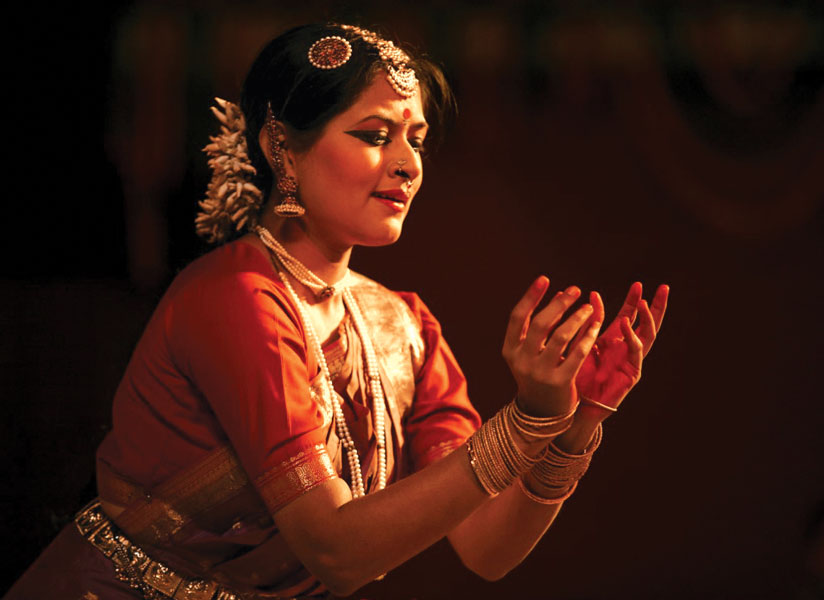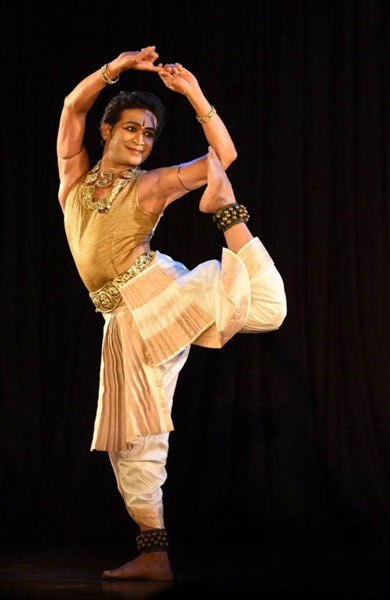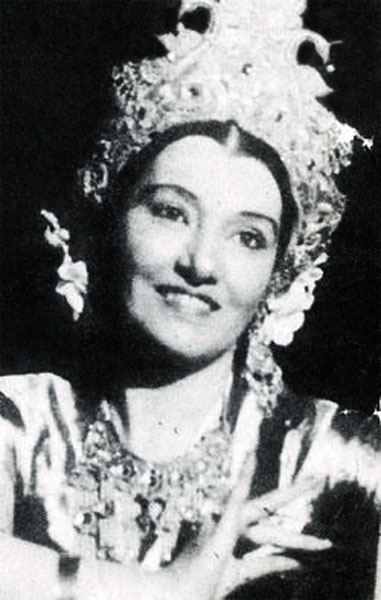A spectacular vision of dance etched forever in my mind is watching a thousand dancers performing Bharatanatyam in the central courtyard of the majestic Brahadeeswara temple in Thanjavur to commemorate the Millennium celebrations of the temple. What a resplendent sight it was! Truly an unforgettable and once in a lifetime experience! It was a feast for the senses to see a confluence of multi-national, multilingual and multi-religious dancers from all over the world dancing in perfect harmony without ever practising together. This mega dance event was conceived and coordinated by the renowned Bharatanatyam exponent, Dr Padma Subrahmanyam, and orchestrated by a higher power. I was fortunate to witness and also direct the live telecast of this magnificent performance for television viewers across India.

The Brahadeeswara temple is an architectural marvel that has witnessed over a thousand years of history. It was in these hallowed precincts that Bharatanatyam was performed centuries ago as a temple worship ritual. It was here that the names of dancers and musicians were inscribed on the temple walls. This was the city where kings nurtured and encouraged fine arts; this was the perfect environment where the Tanjore quartet systematically devised a concert format for dance and composed many immortal songs that are performed even today.
Dance helped me in facing a tough life, a highly demanding job and managing a chronic disease like rheumatoid arthritis.
— Kamalini Dutt, former Deputy Director, General of Doordarshan
Sep 25, 2010, was the historic day when the picturesque temple glowed with soul-stirring worship through the dance of a thousand devoted dancers. This perfect coexistence of art and architecture, traditions and technology can best describe the relevance of Bharatanatyam in today’s world.
Originating in Tamil Nadu, Bharatanatyam is probably the oldest classical dance tradition of India dating back to over 2,000 years according to available literature. As the dance style evolved from the temple dances of South India, it remains a classical art that combines artistic expression with spirituality even today. T Balasaraswati, a Bharatanatyam Devadasi, described the essence of this exquisite dance style thus: “Bharatanatyam is an art that consecrates the body… the dancer, who dissolves her identity in rhythm and music, makes her body an instrument, at least for the duration of the dance, for the experience and expression of the spirit.”
Bharatanatyam was earlier known as Sadir, and the new name was coined only in the early 20th century. The name was derived from sage Bharata who wrote the Natya Shastra treatise on arts two millennia ago. Another interpretation is that it is an acronym of bha for bhavam or expressions, ra for ragam or medium and tha for thalam or rhythm which combine to make natyam or dance.

The intrinsic beauty of Bharatanatyam is meant to be a cathartic experience for the audience that transcends beyond the knowledge of language and technique. Earlier, it used to be performed only by members of certain families in South India and the art has been handed down over the centuries through generations of ritualistic dancers known as Devadasis. Traditionally, it used to be a solo dance mostly performed by women.
The dancer was accompanied by a guru or nattuvanar conducting the performance, a singer rendering the vocals, a percussionist for rhythm on the mridangam or thavil and wind instruments like nadaswaram or flute and string instruments like veena or violin were added for melody. The technique is based on an elaborate vocabulary of hand, foot, face and body movements performed to the accompaniment of dance syllables. The dance is an amalgamation of three elements, namely, pure dance or Nritta, a combination of expressions and rhythm or Nritya, and the dramatic element or Natya. The facial expressions known as abhinaya are based on the nine universal emotions known as navarasas — shringara (love), hasya (humour), karuna (grief), raudra (anger), veera (valour), bhayanaka (fear), bhibhatsa (disgust), adbhuta (wonder) and shantam (peace). The roots of abhinaya are found in the Natyashastra text which defines rasa as the highest aesthetic experience for both the dancer and the spectator.
The intrinsic beauty of Bharatanatyam is meant to be a cathartic experience for the audience that transcends beyond the knowledge of language and technique.
Celebrated Bharatanatyam dancer Alarmel Valli shares her passion for dance — “For me, the greatness of Bharatanatyam lies in its inherent ability to harmonise the physical, intellectual, emotional and spiritual dimensions of life. The dancer is at once the sculptor, sculpting and structuring space, in forms both graceful and powerful. She is the painter, adding tints and hues to a line drawing, bringing it to life. She is the poet, writing her poems with movements, gestures and expressions. Ultimately she is the seeker, whose dance becomes a transcendental, transforming experience — a joyous prayer with one’s very being.”
Bharatanatyam is a dynamic, vibrant living tradition today that has incorporated music, literature, sculpture and theatre to offer the artist infinite scope for creative explorations. To understand and appreciate the beauty of the Bharatanatyam repertoire, let us take a walk through the Margam or path of the dance performance. The legendary dancer T Balasaraswathi reverently describes it in these words — “The Bharatanatyam recital is structured like a Great Temple. We enter through the outer Gopuram (Hall) of Alarippu, cross the Ardha Mantapam (half way hall) with Jatiswaram, then the Mantapam of Sabdam and enter the holy precinct of the Varnam.”

“This is the place, the space that gives the dancer expansive scope to revel in the rhythm, moods and music of the dance. The varnam is the perpetuity which gives ever-expanding room to the dancer to delight in her self-fulfillment, by providing the fullest scope to her own creativity as well as to the tradition of art.” The padam is a soul-stirring dance replete with emotions depicted through intense expressions followed by an outburst of pure joy through the tillana. The dancer completes the traditional margam by emoting to a devotional verse that is profound in its simplicity and invokes God’s blessings for the artists, audience and the universe.
Shiva is the primordial source and embodiment of all movement, sound and beauty and He is worshipped as the Cosmic dancer Nataraja, the Lord of dance. According to Indian mythology, Shiva and his consort Parvati represent the inseparable opposing and complementary masculine and feminine forces, the Yin and the Yang. Legend has it that the couple participated in a grand dance duet attended by all the celestials where Parvati matched Shiva step for step and pose for pose. When Shiva finally performed the Oordhva Tandavam with one foot on the ground and the other stretched over his head, Parvati declined to follow suit as she was overcome by shyness and felt it may be unbecoming to do the same. The 108 karanas or postures of his enthralling dance have been captured in the exquisite stone carvings of the Thillai Nataraja temple in Chidambaram.
Kamalini Dutt, dancer and former Deputy Director General of Doordarshan, India, shares how Bharatanatyam impacted her life. “I was 18 — an age when one would question everything that came one’s way. What was I learning — Bharatanatyam, philosophy, bhakti, Shiva’s omnipresence or a path to self-realisation? I realised I was a medium to connect past, present and future.”
Thevaram written a few centuries ago came alive through her “mind, body and soul. I realised, our oral traditions, particularly performing arts, in this case — Bharatanatyam, are an integral part of the great Tamil culture. I imbibed the nuances of the highest aesthetic sensibility and values of an inclusive society the saint poets dreamt of.”
But when she was 19, she met with a near fatal accident which slowly brought an end to her dancing. “I got a job in DD which in a way changed the course of my life but dance never left me, even for a second. It morphed into creative ideas which empowered me to transform television productions as an artwork. Dance helped me in facing a tough life, a highly demanding job and managing a chronic disease like rheumatoid arthritis. It also held my hand when I faced challenges in a male-dominated work space. In my inward journey, Bharatanatyam is my best friend. It has helped me to learn that body is a very important medium but to touch one’s core, one has to go beyond.”

Bharatanatyam remained exclusive to the Hindu temples and palaces through the 19th century and reached great artistic heights under the Thanjavur kings. After a ban on the Devadasi system in the early 20th century, it moved to the cities and rapidly gained popularity all over India and also internationally.
Rukmini Devi Arundale was a trendsetter who established Kalakshetra at Madras in 1936, which was the first dance academy where Bharatanatyam was taught. Mrinalini Sarabhai was also a pioneer who popularised Bharatanatyam through her Darpana Academy of Performing Arts in Ahmedabad. Esther Sherman, an American dancer, who came to India in 1930 to learn classical dance was probably the first non-Devadasi dancer to revive the art and perform in India and Europe. She became known as Ragini Devi and started a dance studio in New York where Bharatanatyam was taught.
T Balasaraswati was the first Indian classical dancer who performed Bharatanatyam outside India and is responsible for putting Indian classical dance on the world map. It is thanks to the pioneering efforts of these amazing dancers that classical dance is enjoying its present-day glory. Bharatanatyam has evolved into a multi-dimensional dance style that includes solo and group presentations that have progressed beyond religious, social and linguistic barriers. Dancers are drawn to it as it challenges them intellectually and artistically to create new work which appeals to the enlightened and evolved global audiences. Today, Bharatanatyam remains one of the most widely performed dance styles all over the world by both female and male dancers.





